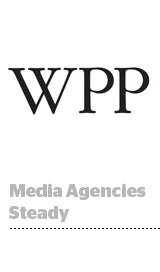 With the Omnicom-Publicis merger now in some doubt, WPP Group retains a glimmer of hope that it could remain the world’s largest agency holding company past the third quarter.
With the Omnicom-Publicis merger now in some doubt, WPP Group retains a glimmer of hope that it could remain the world’s largest agency holding company past the third quarter.
In its Q1 earnings report Friday, WPP listed media investment – represented by its GroupM network and the Xaxis ad tech unit – as among its strongest performing sectors. Read the earnings release.
Growth in media services – particularly digital and data-driven media – was also evident in upbeat Q1 reports from WPP rivals Interpublic Group (IPG), Omnicom Group and MDC Partners.
Meanwhile Publicis’ ZenithOptimedia and IPG’s Magna Global have upwardly revised their global media investment forecasts for 2014. This momentum runs contrary to the narrative that media agencies are under threat of disintermediation as ad-buying automation takes hold. Or, if that trend is real, it has yet to inflict real pain.
WPP’s media investment businesses grew 10% as measured by gross margin and net sales, and GroupM generated new media billings of $586 million (£366 million) during the quarter across Xaxis, Mindshare, MEC, MediaCom, GroupM Search and other agencies. Much of that was likely in digital media, contributing to the $10 billion GroupM already invests across addressable channels.
WPP does not break out programmatic spend, but the company has given its Xaxis “programmatic platform” plenty of room to run, suggesting it likes the revenue growth and margins it generates. Xaxis has made a string of acquisitions in recent months and absorbed its internal sibling 24/7 Media. The result has been a more robust publisher offering, priming Xaxis to do more exclusive supply deals that Global CEO Brian Lesser believes distinguish it from its trading desk rivals.
(As an aside: Even within digital, WPP’s mix is changing dramatically. In 2013, GroupM spent more with Yahoo than Facebook, GroupM Chief Digital Officer Rob Norman told an audience at AdExchanger’s Programmatic I/O conference last month. With Facebook’s stunning ad revenue growth – 82% in Q1 – it’s unlikely that pattern would repeat in 2014.)
Speaking of rivals, Omnicom Group, IPG and MDC Partners have also reported Q1 strength in digital media investment, driven in part by data-augmented buying.
For Omnicom Group, Q1 brought an uptick in programmatic interest from branding advertising clients – a fairly new trend that appears to be gaining steam. “Within the brand advertising category, we had very strong overall growth in media, including high double-digit increases in search and programmatic buying.”










